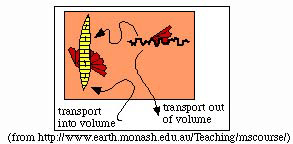
Recall the information given about diffusion, particularly grain-boundary diffusion and volume diffusion given in an earlier section.
When a rock is subjected to nonhydrostatic stress, some grain boundaries will be under deviatoric compression and others will be under deviatoric tension. This small change in stress causes a change in Gibbs free energy that can drive dissolution of minerals (typically in response to compression) and their reprecipitation in veins or along grain boundaries (typically in response to tension):
Stylolites are subplanar, wavy features developed where insoluble residues remain behind when the soluble material has been carried away by grain-boundary diffusion:
View formation of a stylolite
Veins are subplanar concentrations of minerals that have precipitated
from solution. They form when a solution is saturated with respect to a particular
dissolved mineral. In quartz, for example, the solubility of silica in aqueous
(H2O-rich) solutions decreases dramatically with decreasing temperature,
such that quartz dissolves into fluid at high temperature, but then precipitates
as the solution cools and becomes supersaturated:
An array of veins in sandstone (Costa Rica):
Another array of en-echelon veins in China:
A larger vein in outcrop:
View cracking and void formation during
brittle-ductile deformation
A special kind of vein called a crack-seal vein forms by repeated
cracking along the vein edge, which leads to a line of wall fragments:
An antitaxial vein:
View formation of a vein during deformation
A vein with large quartz candles:
View growth of quartz candles into a vug or vein
Fibres that grow inside fault planes provide important information
about sense of fault motion. This is a normal fault:
Strain shadows are a kind of grain-scale vein that forms from dissolution of material elsewhere and reprecipitation in the dilatational side of a porphyroclast or other hard grain. Strain caps form on the opposing sides of the porphyroclast where material has dissolved.
Strain shadows in a metagabbro in the Sierra Nevada:
So-called composite foliations can be used to determine sense of shear. This greenschist-facies rock from Norway shows sinistral (left-lateral) sense of shear:
This amphibolite-facies gneiss from China shows dextral (left-lateral) sense of shear:
Asymmetric boudinage of foliation can also be used to determine sense of shear, and, in some rocks, important information about the P-T-deformation history can be learned from the minerals in the boudin necks:
At low temperature, most rocks deform by cracking and frictional sliding. At high temperature, however, ductile deformation (such as seen in these rocks north of Annapurna) is accomplished by a range of thermally activated processes.
Dislocation or line defect: a line in a crystal where there is a lattice mismatch (recall from our diffusion discussion that diffusion occurs via the motion of point defects). Dislocations can form during growth, but are chiefly formed by deformation. Here are two transmission-electron images of dislocations:
Dislocation glide: crystal deformation by the motion of dislocations
in a specific slip direction within a specific glide plane.
Together the slip direction and glide plane define a unique slip system.
Dislocation glide results in undulatory extinction (which is nothing more
than a bent crystal lattice) and lattice preferred orientation.
Five independent slip systems are required for a grain to undergo an arbitrary
imposed deformation (this is called the von Mises criterion).
View one movie and a second movie showing
the motion of a single dislocation (from http://www.earth.monash.edu.au/Teaching/mscourse/)
Undulatory extinction: spatial variation in birefringence caused
by a bent crystal lattice. Undulatory extinction can be the result of
dislocation glide or cracking.
View the formation of undulatory extinction. The
most extreme texture that results from dislocation glide is the formation
of ribbon
grains (typically in quartz and enstatite).
Twins are produced by the motion of special dislocations that have
split in two:
As dislocation glide proceeds, the dislocations tend to run into each
other, forming tangles, and pile up in front of obstacles. This impedes
further
dislocation generation, makes the grain harder to deform, and adds
strain free energy to the grain. This process is called work hardening.
If deformation of the grain is going to continue, some process must
remove the
tangled and piled up dislocations. Recovery from this state
can occur via two processes: grain-boundary recrystallization, and
subgrain-rotation
recrystallization.
In grain-boundary migration, the strain free energy of deformed
grains becomes so high that a grain boundary sweeps through the deformed
grain,
producing a new strain-free grain. Then the process of dislocation
glide can start over again.
Here is an optical microscope image (crossed polarized light) of
subgrains in quartz:
View the formation of subgrains by grain-boundary migration
The hallmark microstructures of grain-boundary recrystallization
are sutured grain boundaries.
In subgrain-rotation recrystallization the temperature is
high enough the dislocations can climb out of their glide plane
to bypass
obstacles
or climb into dislocations of opposite sign and annihilate.
Dislocation climb: is the movement of dislocations in directions
not within their glide plane via diffusion. This allows the arbitrary
movement of dislocations over obstacles, into other dislocations,
and into lower
energy
configurations.
dislocation creep: dislocation glide + diffusion, permitting
arbitrary deformation of crystal
The motion of dislocations into lower energy configurations produces
tilt walls (composed of edge dislocations) and twist walls (composed
of screw
dislocations) that bound subgrains of slightly different orientation:
As deformation continues, the angular difference between subgrains
increases, until eventually the subgrain is so different in
orientation from its
parent grain that it is considered to be a separate grain.
View the formation of subgrains by rotation recrystallization
View one movie and a second movie of
dynamic recrystallization
A specific stress on a grain produces a specific density of
dislocations. This increase in dislocation density leads to
a decrease in grain
size (and recrystallized grain size), such that recrystallized
grain size
can be used
as a paleo stress gauge or paleopiezometer.
The hallmark microstructures of subgrain-rotation recrystallization
are core-mantle textures,
where a host porphyroclast is surrounded by new, smaller subgrains.
If many grains in a rock undergo the same rotation, a lattice preferred orientation (LPO) develops. LPO's are non-random orientation of crystals produced by dislocation glide.
In thin section, an LPO is often visible as large areas of similar birefringence:
The strength of a preferred orientation depends on the magnitude of
strain, although it may reach a maximum at quite low strains. The strength
of an LPOs
can thus be used as a qualitative guide to strain magnitude.
The shape of the LPO that develops depends on the slip systems that
are operating. Quartz for example, undergoes basal glide at low temperatures
(slip
along the {0001} plane in any of the 3 a directions), prism slip at moderate
temperatures (slip along the prism planes in any of the 3 a directions),
and
c-slip at high temperatures (slip along the prism planes in any of the c
direction). Specific LPOs can thus be used as a guide to deformation temperature.
The symmetry of the LPO that develops depends on whether the deformation
history is coaxial or noncoaxial. LPOs that are symmetrical with respect to
the foliation and lineation develop from coaxial deformation histories, and
those that are asymmetrical develop from noncoaxial deformation histories.
For example, the deformation of quartzites in the Dabie Shan of China is interpreted
as coaxial deformation by basal glide (left), non-coaxial deformation by basal
glide (center), and coaxial deformation by prism slip (right):
View the development of a crystallographic fabric
View the development of the lattice preferred orientation
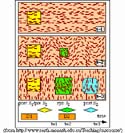
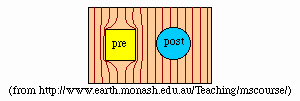
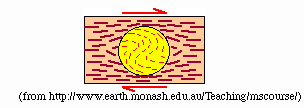

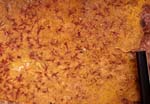
The first experiments to show this were by Raleigh & Paterson (1965):
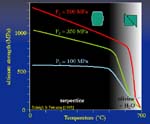
Gypsum dehydrates to anhydrite + H2O at ~90°C:
The addition of H2O to samples of synthetic gouge undergoing frictional sliding causes a reduction in strength, probably related to enhancement of solution-transfer creep
Partial melting can cause a similar marked weakening and magma-fracturing. This occurred during eclogite-facies metamorphism in Norway:
Phase transformations can also cause weakening of rock through the production of fine grain size. This Rapikivi granite in Norway underwent large-scale deformation during eclogite-facies metamorphism:
Grain-size reduction through cracking or dislocation creep produces more grain-boundary area, which aids metamorphic reactions by adding interfacial free energy and diffusive pathways.
The motion of dislocations through crystals can act as sweeps to change crystal composition.
Earthquakes produce high-permeability fault zones along which alteration can then occur. High-pressure faulting events in this otherwise dry Norwegian granulite permitted the ingress of fluids and conversion to eclogite: